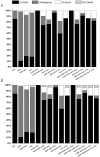DNA Barcode Authentication and Library Development for the Wood of Six Commercial Pterocarpus Species: the Critical Role of Xylarium Specimens
- PMID: 29386565
- PMCID: PMC5792460
- DOI: 10.1038/s41598-018-20381-6
DNA Barcode Authentication and Library Development for the Wood of Six Commercial Pterocarpus Species: the Critical Role of Xylarium Specimens
Abstract
DNA barcoding has been proposed as a useful tool for forensic wood identification and development of a reliable DNA reference library is an essential first step. Xylaria (wood collections) are potentially enormous data repositories if DNA information could be extracted from wood specimens. In this study, 31 xylarium wood specimens and 8 leaf specimens of six important commercial species of Pterocarpus were selected to investigate the reliability of DNA barcodes for authentication at the species level and to determine the feasibility of building wood DNA barcode reference libraries from xylarium specimens. Four DNA barcodes (ITS2, matK, ndhF-rpl32 and rbcL) and their combination were tested to evaluate their discrimination ability for Pterocarpus species with both TaxonDNA and tree-based analytical methods. The results indicated that the combination barcode of matK + ndhF-rpl32 + ITS2 yielded the best discrimination for the Pterocarpus species studied. The mini-barcode ndhF-rpl32 (167-173 bps) performed well distinguishing P. santalinus from its wood anatomically inseparable species P. tinctorius. Results from this study verified not only the feasibility of building DNA barcode libraries using xylarium wood specimens, but the importance of using wood rather than leaves as the source tissue, when wood is the botanical material to be identified.
Conflict of interest statement
The authors declare that they have no competing interests.
Figures






Similar articles
-
A strategy for developing high-resolution DNA barcodes for species discrimination of wood specimens using the complete chloroplast genome of three Pterocarpus species.Planta. 2019 Jul;250(1):95-104. doi: 10.1007/s00425-019-03150-1. Epub 2019 Mar 28. Planta. 2019. PMID: 30923906
-
Machine learning approaches outperform distance- and tree-based methods for DNA barcoding of Pterocarpus wood.Planta. 2019 May;249(5):1617-1625. doi: 10.1007/s00425-019-03116-3. Epub 2019 Mar 1. Planta. 2019. PMID: 30825008
-
DNA barcoding of vouchered xylarium wood specimens of nine endangered Dalbergia species.Planta. 2017 Dec;246(6):1165-1176. doi: 10.1007/s00425-017-2758-9. Epub 2017 Aug 19. Planta. 2017. PMID: 28825134
-
DNA barcoding, an effective tool for species identification: a review.Mol Biol Rep. 2023 Jan;50(1):761-775. doi: 10.1007/s11033-022-08015-7. Epub 2022 Oct 29. Mol Biol Rep. 2023. PMID: 36308581 Review.
-
Molecular genetic tools to infer the origin of forest plants and wood.Appl Microbiol Biotechnol. 2010 Feb;85(5):1251-8. doi: 10.1007/s00253-009-2328-6. Epub 2009 Nov 13. Appl Microbiol Biotechnol. 2010. PMID: 19911178 Free PMC article. Review.
Cited by
-
Fraud and misrepresentation in retail forest products exceeds U.S. forensic wood science capacity.PLoS One. 2019 Jul 25;14(7):e0219917. doi: 10.1371/journal.pone.0219917. eCollection 2019. PLoS One. 2019. PMID: 31344141 Free PMC article.
-
Screening of potential chemical marker with interspecific differences in Pterocarpus wood and a spatially-resolved approach to visualize the distribution of the characteristic markers.Front Plant Sci. 2023 Feb 14;14:1133848. doi: 10.3389/fpls.2023.1133848. eCollection 2023. Front Plant Sci. 2023. PMID: 36866375 Free PMC article.
-
Plastid genome evolution of a monophyletic group in the subtribe Lauriineae (Laureae, Lauraceae).Plant Divers. 2021 Dec 14;44(4):377-388. doi: 10.1016/j.pld.2021.11.009. eCollection 2022 Jul. Plant Divers. 2021. PMID: 35967258 Free PMC article.
-
DNA barcoding: an efficient technology to authenticate plant species of traditional Chinese medicine and recent advances.Chin Med. 2022 Sep 28;17(1):112. doi: 10.1186/s13020-022-00655-y. Chin Med. 2022. PMID: 36171596 Free PMC article. Review.
-
A strategy for developing high-resolution DNA barcodes for species discrimination of wood specimens using the complete chloroplast genome of three Pterocarpus species.Planta. 2019 Jul;250(1):95-104. doi: 10.1007/s00425-019-03150-1. Epub 2019 Mar 28. Planta. 2019. PMID: 30923906
References
-
- Dormontt EE, et al. Forensic timber identification: It’s time to integrate disciplines to combat illegal logging. Biol. Conserv. 2015;191:790–798. doi: 10.1016/j.biocon.2015.06.038. - DOI
-
- Sun L, Bogdanski BEC. Trade incentives for importers to adopt policies to address illegally logged timber: The case of non-tropical hardwood plywood. J. Forest Econ. 2017;27:18–27. doi: 10.1016/j.jfe.2017.01.003. - DOI
-
- The Plant List Version 1. 1. http://www.theplantlist.org (2013).
-
- Maclachlan IR, Gasson P. PCA of cites listed Pterocarpus santalinus (Leguminosae) wood. IAWA J. 2010;31:121–138. doi: 10.1163/22941932-90000010. - DOI
Publication types
MeSH terms
Substances
LinkOut - more resources
Full Text Sources
Other Literature Sources
Miscellaneous

